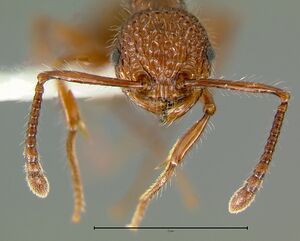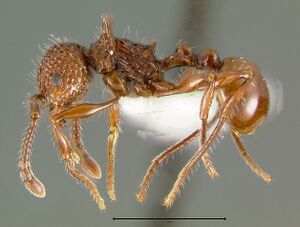Pristomyrmex bicolor
| Pristomyrmex bicolor | |
|---|---|

| |
| Scientific classification | |
| Kingdom: | Animalia |
| Phylum: | Arthropoda |
| Class: | Insecta |
| Order: | Hymenoptera |
| Family: | Formicidae |
| Subfamily: | Myrmicinae |
| Tribe: | Crematogastrini |
| Genus: | Pristomyrmex |
| Species: | P. bicolor |
| Binomial name | |
| Pristomyrmex bicolor Emery, 1900 | |
| Synonyms | |
| |
This species occurs in rainforest and has been collected on fallen trees and rotten logs.
Identification
Wang (2003) - Worker. Masticatory margin of mandible with four teeth and a long diastema after the preapical tooth; pronotal spines exceptionally long (usually 0.40-0.66), much longer than propodeal armaments (teeth or short spines); dorsum of head sculptured with coarse rugoreticulum. P. bicolor is a highly variable species.
Only slight differences separate the workers of P. bicolor and of Pristomyrmex costatus, as follows: P. bicolor - Pronotal spines well developed and exceptionally long, usually 0.40 to 0.66 (rarely 0.37-0.39), and usually longer than the distance between their bases. Dorsal surfaces of petiole node and postpetiole usually with one to three pairs of hairs. Area between the bases of the pronotal spines smooth or sculptured; if sculptured, pronotal spine length is over 0.40. Larger species (HW usually 1.20-1.46, rarely 1.04-1.19; HL usually 1.20-1.42, rarely 1.08-1.19)
P. costatus - Pronotal spines moderately long, usually 0.18 to 0.27 (rarely 0.32), and shorter than the distance between their bases. Dorsal surfaces of petiole node and postpetiole with five or more pairs of hairs. Entire dorsum of alitrunk with developed rugoreticulum. Smaller species (HW 0.90- 1.16, HL 0.91-1.16)
Characters separating P. bicolor from Pristomyrmex curvulus are provided under P. curvulus. Pristomyrmex bicolor is also very similar in appearance to Pristomyrmex trachylissus. The two species are all from the Oriental region. The separation of the two species is summarized under P. trachylissus
A member of the Quadridens species group
Keys including this Species
Distribution
Latitudinal Distribution Pattern
Latitudinal Range: 4.533333333° to 4.199°.
| North Temperate |
North Subtropical |
Tropical | South Subtropical |
South Temperate |
- Source: AntMaps
Distribution based on Regional Taxon Lists
Indo-Australian Region: Borneo, Indonesia (type locality), Malaysia, Philippines, Singapore.
Distribution based on AntMaps
Distribution based on AntWeb specimens
Check data from AntWeb
Countries Occupied
| Number of countries occupied by this species based on AntWiki Regional Taxon Lists. In general, fewer countries occupied indicates a narrower range, while more countries indicates a more widespread species. |

|
Estimated Abundance
| Relative abundance based on number of AntMaps records per species (this species within the purple bar). Fewer records (to the left) indicates a less abundant/encountered species while more records (to the right) indicates more abundant/encountered species. |

|
Biology
|
Castes
Males have not been collected.
Worker
  
| |
| . | Owned by Museum of Comparative Zoology. |
Images from AntWeb
   
| |
| Syntype of Pristomyrmex trachylissus bicolor. Worker. Specimen code casent0904691. Photographer Will Ericson, uploaded by California Academy of Sciences. | Owned by MSNG, Genoa, Italy. |
Nomenclature
The following information is derived from Barry Bolton's Online Catalogue of the Ants of the World.
- bicolor. Pristomyrmex trachylissa var. bicolor Emery, 1900d: 678 (w.) INDONESIA (Sumatra). Wang, M. 2003: 427 (q.). Raised to species and senior synonym of taurus: Wang, M. 2003: 425.
- taurus. Pristomyrmex taurus Stitz, 1925: 120, fig. 5 (w.) PHILIPPINES. Junior synonym of bicolor: Wang, M. 2003: 425.
Unless otherwise noted the text for the remainder of this section is reported from the publication that includes the original description.
Description
Worker
Wang (2003) - TL 4.58-6.14, HL 1.04-1.42, HW 1.08-1.46, CI 98-109, SL 1.14-1.58, SI 106-120, EL 0.20-0.26, PW 0.65-0.96, AL 1.18-1.64, PPW 0.33-0.40, PPL 0.38-0.48, PPI 77-93 (n = 83).
Mandibles usually with several longitudinal rugae, varying from superficial to rather coarse. Masticatory margin of mandible with four teeth arranged as: two adjacent strong apical teeth + a long diastema + two small basal teeth that are roughly the same size. Basal margin of mandible lacking a distinctly curved lobe or tooth. Clypeus with a strong median longitudinal carina. Anterior clypeal margin sometimes with seven denticles: a median denticle and three others on each side, but sometimes one or a few are weak or indistinct, or two to three of the lateral denticles are fused into a larger one. Ventral center of clypeus usually with a transverse ruga of varying length, sometimes with a very weak prominence at middle and sometimes without either of these characters. Palp formula 1,3. Frontal carinae strong, extending to the level of the posterior margins of eyes. Slightly concave scrobal areas pre sent. Frontal lobes absent; thus, the antennal articulations are entirely exposed. Antennal scapes, when lying on the dorsal head, usually surpassing the occipital margin by one-third to one-fourth of their length. Eyes usually containing 10 to 12 ommatidia in the longest row.. Pronotal spines well developed and exceptionally long, varying in length, usually 0.40 to 0.66, but in a few specimens they are 0.37 to 0.39. Propodeum usually with a pair of acute short spines, which are 0.12 to 0.20, much more slender and much shorter than the pronotal ones. Propodeal armaments occasionally reduced to a pair of teeth. Both pronotal and propodeal spines upward pointed. Metapleural lobes subtriangular. In profile, petiole node high, with a long anterior peduncle; its anterodorsal angle elevated above the posterodorsal. In dorsal view, crest of petiole node rounded. Postpetiole in profile convex dorsally, in dorsal view longer than broad and broadening from front to back. Dorsum of head with well-developed coarse rugoreticulum. Dorsal surface of alitrunk variably sculpture d: At one extreme, in a series from North Borneo (SE, Forest Camp, 9.8 km SW of Tenom), the dorsum of alitrunk is entirely rugoreticulate. In a few other series, the rugoreticulum is absent between the bases of two pronotal spines, and some weak rugae or a smooth (broad or narrow) area are present there. At the other extreme, the sculpture is completely absent, and the area is smooth and shining on the anterior half of the dorsum, but the rest of the dorsal alitrunk is coarsely rugulose. Sides of pronotum with a rugoreticulum or many large coarse foveolate punctures. Sides of the rest of alitrunk irregularly coarsely rugulose . Dorsal surfaces of petiole node and postpetiole smooth and shining, but a longitudinal ruga present on each side of petiole. Gaster unsculptured, smooth, and shining. Dorsal surfaces of head and alitrunk with numerous erect or suberect hairs. Petiole node with a few (usually two to three) pairs of hairs dorsally. Dorsum of postpetiole with at least a pair of hairs. First gastral tergite lacking erect or suberect hairs. A row of forward projecting hairs present near the anterior clypeal margin. Scapes and tibiae with some erect or suberect hairs. Color usually reddish-brown but sometimes black-brown.
Queen
Wang (2003) - TL 6.54, 6.56; HL 1.34, 1.44; HW 1.38, 1.50; CI 103, 104; SL 1.48, 1.51; SI 99, 109; EL 0.32, 0.34; PW 1.20, 1.24; AL 1.72, 1.82; PPW 0.41, 0.43; PPL 0.48, 0.48; PPI 85, 90 (n = 2).
General shape with normal caste differences from the conspecific worker; pronotum unarmed. Other characters similar to worker.
Type Material
Wang (2003):
Syntype workers, Sumatra: Si-Rambe, xii.l890-iii.1891 (E. Modigliani) (Museo Civico di Storia Naturale, Genoa, NHMV, National Museum of Natural History) [examined].
Pristomyrmex taurus Holotype worker, Philippines: N. Palawan, Binaluan, xi.xii.1913 (G. Boettcher) (Berlin Museum für Naturkunde der Humboldt-Universität) [examined].
References
- Emery, C. 1900d. Formiche raccolte da Elio Modigliani in Sumatra, Engano e Mentawei. [part]. Ann. Mus. Civ. Stor. Nat. 40[=(2(20): 661-688. (page 678, worker described)
- Khachonpisitsak, S., Yamane, S., Sriwichai, P., Jaitrong, W. 2020. An updated checklist of the ants of Thailand (Hymenoptera, Formicidae). ZooKeys 998, 1–182 (doi:10.3897/zookeys.998.54902).
- Wang, M. 2003. A Monographic Revision of the Ant Genus Pristomyrmex (Hymenoptera:Formicidae). Bulletin of the Museum of Comparative Zoology 157(6): 383-542. (page 425, Raised to species, senior synonym of taurus; page 427, figs. 111-112 queen described)
- Wang, W.Y., Soh, E.J.Y., Yong, G.W.J., Wong, M.K.L., Benoit Guénard, Economo, E.P., Yamane, S. 2022. Remarkable diversity in a little red dot: a comprehensive checklist of known ant species in Singapore (Hymenoptera: Formicidae) with notes on ecology and taxonomy. Asian Myrmecology 15: e015006 (doi:10.20362/am.015006).
References based on Global Ant Biodiversity Informatics
- Davidson D. W., S. C. Cook, R. R. Snelling and T. H. Chua. 2003. Explaining the Abundance of Ants in Lowland Tropical Rainforest Canopies. Science 300: 969-972.
- Emery C. Formiche raccolte da Elio Modigliani in Sumatra, Engano e Mentawei. Annali del Museo Civico di Storia Naturale 40: 661-722.
- Emery, C. "Formiche raccolte da Elio Modigliani in Sumatra, Engano e Mentawei." Annali del Museo Civico di Storia Naturale Giacomo Doria (Genova) (2) 20, no. 40 (1900): 661-722.
- Herwina H., R. Satria, Yaherwandi, and Y. Sakamaki. 2018. Subterranean ant species diversity (Hymenoptera: Formicidae) in educational and biological research forest of universitas andalas, Indonesia. Journal of Entomology and Zoology Studies 6(1): 1720-1724.
- Laciny A., H. Zettel, A. Pal, and D. Zimmermann. 2016. The ant genus Pristomyrmex (Insecta: Hymenoptera: Formicidae) in the collection of the Natural History Museum Vienna. Ann. Naturhist. Mus. Wien B 118: 61-72.
- Pfeiffer M.; Mezger, D.; Hosoishi, S.; Bakhtiar, E. Y.; Kohout, R. J. 2011. The Formicidae of Borneo (Insecta: Hymenoptera): a preliminary species list. Asian Myrmecology 4:9-58
- Philpott S.M., P. Bichier, R.A. Rice, and R. Greenberg. 2008. Biodiversity conservation, yield, and alternative products in coffee agroecosystems in Sumatra, Indonesia. Biodivers. Conserv. 17: 1805-1820. Data obtained from Stacy Philpott
- Stitz H. 1925. Ameisen von den Philippinen, den malayischen und ozeanischen Inseln. Sitzungsberichte der Gesellschaft Naturforschender Freunde zu Berlin 1923: 110-136.
- Wang M. 2003. A Monographic Revision of the Ant Genus Pristomyrmex (Hymenoptera:Formicidae). Bulletin of the Museum of Comparative Zoology 157(6): 383-542.
- Wang M. 2003. A monographic revision of the ant genus Pristomyrmex (Hymenoptera:Formicidae). Bulletin of the Museum of Comparative Zoology 157(6):383-542
- Zettel, H. 2006. On the ants of the Philippine Islands: 1. The genus Pristomyrmex Mayr, 1866. Myrmecologische Nachrichten 8: 59-68.

